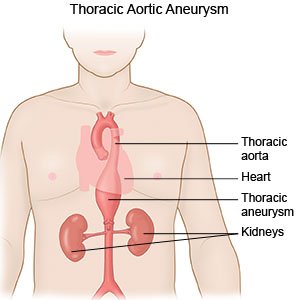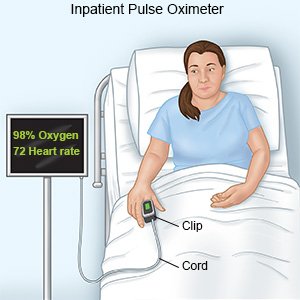Thoracic Aortic Aneurysm
Medically reviewed by Drugs.com. Last updated on Jun 5, 2024.
A thoracic aortic aneurysm (TAA) is a bulge in the upper part of your aorta. The aorta is a large blood vessel that goes from your heart down into your abdomen. The aortic valve opens to let blood flow from your heart into your aorta. The valve then closes to stop blood flowing back into your heart. A TAA can occur if the aorta or its valve is damaged, weakened, or not formed correctly. A TAA may continue to grow and rupture (burst), or it may dissect (tear) suddenly. A TAA that bursts or tears is a life-threatening emergency.
 |
WHILE YOU ARE HERE:
Informed consent
is a legal document that explains the tests, treatments, or procedures that you may need. Informed consent means you understand what will be done and can make decisions about what you want. You give your permission when you sign the consent form. You can have someone sign this form for you if you are not able to sign it. You have the right to understand your medical care in words you know. Before you sign the consent form, understand the risks and benefits of what will be done. Make sure all your questions are answered.
An IV
is a small tube placed in your vein that is used to give you medicine or liquids.
Activity:
Do not get out of bed until your healthcare provider says it is okay. Call a healthcare provider before you get out of bed. Do not try to get out of bed by yourself. Tell your provider if you feel weak, dizzy, or like you are going to faint.
You may need extra oxygen
if your blood oxygen level is lower than it should be. You may get oxygen through a mask placed over your nose and mouth or through small tubes placed in your nostrils. Ask your healthcare provider before you take off the mask or oxygen tubing.
You may need to wear pressure stockings.
The stockings are tight and put pressure on your legs. This improves blood flow and helps prevent clots.
Medicines:
- Blood pressure (BP) medicine helps lower your BP to prevent your TAA from growing, tearing, or bursting.
- Cholesterol medicine may be needed to lower your cholesterol level to help prevent atherosclerosis (hard or stiff arteries).
- Antiplatelet medicine such as aspirin, may be needed to prevent a blood clot in your aorta. You may need aspirin after a procedure to repair your aorta.
- Pain medicine may be given to help decrease your pain. Do not wait until your pain is severe before you ask for more medicine.
Monitoring:
- BP checks will be used to see if BP medicine is working and your BP is okay. Your provider will check your BP often until it is okay.
- Pulse oximetry measures the amount of oxygen in your blood.

- An EKG records your heart rhythm and how fast your heart beats. It is used to check for damage to your heart.
- An arterial line is a tube that is placed into an artery, usually in the wrist. An arterial line may also be used to measure your BP or to take a blood sample.
Tests:
- Blood tests may show if enough blood is getting to your kidneys and how well your kidneys work. You may also need blood tests to check for heart disease and if your blood is clotting well. These can help your provider decide what treatment you need.
- A CT, MRI, or ultrasound may show your TAA has burst or you have a tear in your aorta. You may be given contrast liquid before the scan. Tell the healthcare provider if you have ever had an allergic reaction to contrast liquid. Do not enter the MRI room with anything metal. Metal can cause serious injury. Tell the healthcare provider if you have any metal in or on your body.
- An echocardiogram uses sound waves to show pictures on a monitor. It is used to check your aorta for a burst aneurysm or tear. It may also show how well blood flows through your heart and how well your heart is pumping.
- An x-ray may show signs of bleeding in your chest.
Treatment:
- Endovascular repair is a procedure that uses a graft to prevent your TAA from tearing or bursting. A graft is a wire mesh tube that can also protect your aorta. You may need more than 1 endovascular repair.
- Surgery may be needed to repair your aorta or remove an aneurysm. You may instead need surgery to replace part of your aorta. Your aortic valve may also be replaced if it is not working well.
Treatment options
The following list of medications are related to or used in the treatment of this condition.
RISKS:
You may need 1 or more procedures to repair your aorta. Surgery may cause damage to your spinal cord. Surgery may also cause you to bleed more than expected or get an infection. You may need a blood transfusion to replace the blood you have lost. A large loss of blood can be life-threatening.
CARE AGREEMENT:
You have the right to help plan your care. Learn about your health condition and how it may be treated. Discuss treatment options with your healthcare providers to decide what care you want to receive. You always have the right to refuse treatment.© Copyright Merative 2024 Information is for End User's use only and may not be sold, redistributed or otherwise used for commercial purposes.
The above information is an educational aid only. It is not intended as medical advice for individual conditions or treatments. Talk to your doctor, nurse or pharmacist before following any medical regimen to see if it is safe and effective for you.
Learn more about Thoracic Aortic Aneurysm
Treatment options
Care guides
Further information
Always consult your healthcare provider to ensure the information displayed on this page applies to your personal circumstances.
